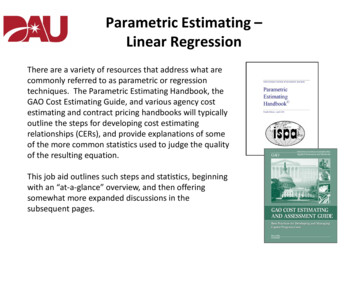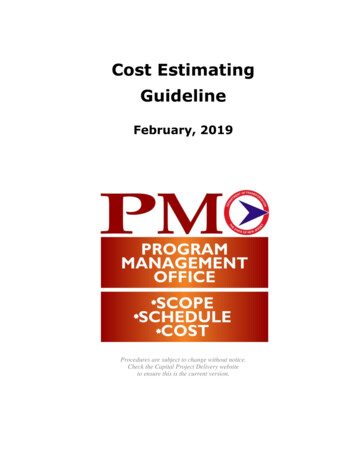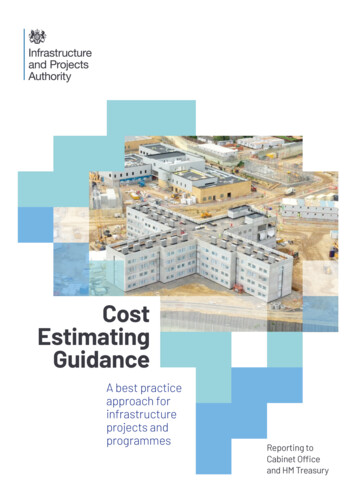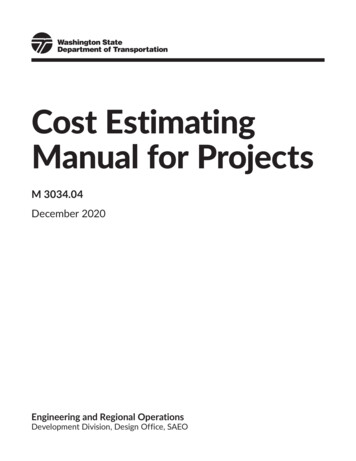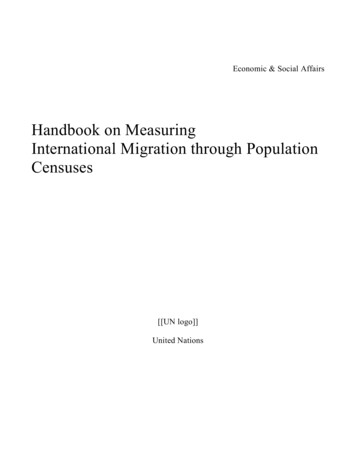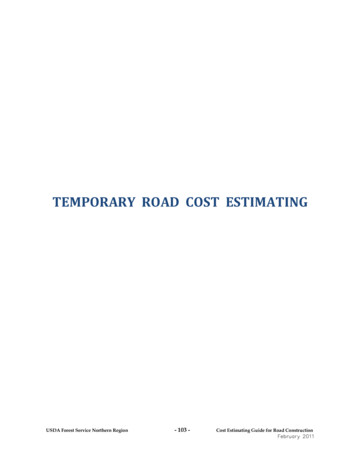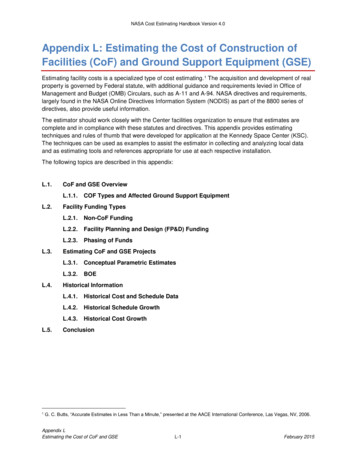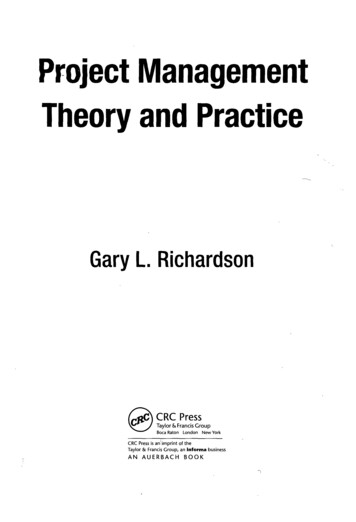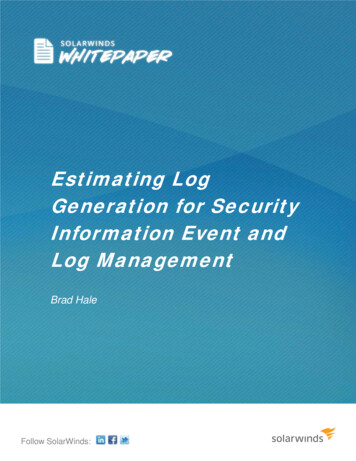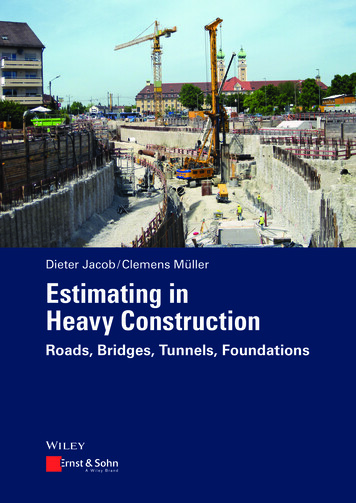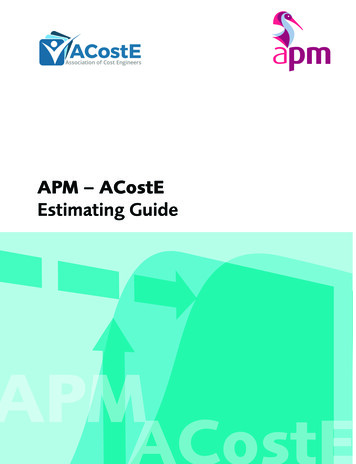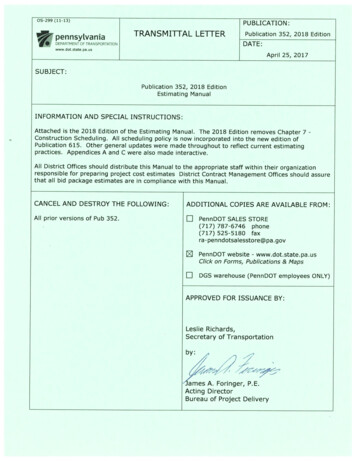
Transcription
ESTIMATING MANUAL2018 EditionView Interactive AppendicesPUB 352 (4-18)
Table of ContentsPublication 352ESTIMATING MANUALCHAPTER 1-INTRODUCTION1.11.21.3GENERAL .1-1ESTIMATING MILESTONES THROUGHOUT PROJECT DEVELOPMENT .1-1A. Planning .1-1B. Scoping .1-2C. Design Field View .1-2D. Final Design Office Meeting .1-2E. PS&E .1-2CONTENTS OF THE ESTIMATING MANUAL .1-2CHAPTER 2-COST MANAGEMENT PROCESS2.12.2ESTIMATING PROCESS BACKGROUND .2-1ESTIMATE MILESTONES.2-3A. Planning Estimate Development .2-4B. Scoping Estimate Development .2-4C. Design Field View Estimate Development .2-4D. Final Design Office Meeting Estimate Development.2-5E. PS&E Development .2-62.3 ESTIMATE DOCUMENTATION.2-6A. Documentation Steps .2-6B. Cost Driver Analysis.2-8C. Project Estimate File .2-9D. Design-Build Cost Estimates .2-9E. Other Estimate Documentation .2-92.4 MAJOR PROJECT PROGRAM COST ESTIMATING .2-10CHAPTER 3-COST ESTIMATING METHODS3.13.23.33.43.53.6INTRODUCTION .3-1PARAMETRIC ESTIMATING .3-1ANALOGOUS OR SIMILAR PROJECT ESTIMATING .3-1HISTORICAL BID-BASED ESTIMATING .3-1HISTORICAL PERCENTAGES ESTIMATING .3-1COST-BASED ESTIMATING .3-1A. Introduction .3-1B. Cost-Based Process.3-2C. Cost-Based Examples and Forms . 3-2D. Sources of Estimating Data and References.3-3E. Identify and Prioritize Items for Cost-Based Estimating .3-3F. Elements of a Cost-Based Estimate .3-4G. Material Cost-Based Element .3-5H. Equipment Cost-Based Element .3-6I.Labor Cost-Based Element .3-8J.Time Cost-Based Element .3-9K. Overhead and Profit Cost-Based Elements .3-11CHAPTER 4-COST ESTIMATING FACTORS4.14.2INTRODUCTION .4-1COST DRIVERS .4-1A. Quantity of Materials .4-1B. Classification of Work .4-2TOC-1
Table of Contents4.34.44.54.64.74.84.94.10Publication 352C. Price-Volatile Materials .4-3D. Availability of Materials .4-3E. Location .4-4F. Time of the Year .4-4G. Phasing of Operations .4-5H. Project Type.4-6I.Maintenance and Protection of Traffic.4-6J.Permit Conditions and Requirements .4-7K. Additional Items to Consider for Construction Cost Estimate .4-8LUMP SUM ITEMS .4-10A. Mobilization .4-11B. Maintenance and Protection of Traffic.4-11C. Clearing and Grubbing.4-12D. Demolition and Bridge Removal .4-12INNOVATIVE BID PROCEDURES .4-12SUBCONTRACT ITEMS .4-13COST DRIVER ANALYSIS.4-13COST ESCALATION .4-13A. Project Scope. .4-14B. Scope Creep .4-14C. Ambiguous Contract Provisions .4-14D. Project Document Quality.4-14E. Local Concerns and Requirements .4-14F. Market Conditions or Changes .4-14G. Contractor Factors .4-15H. Site Investigation and Research . 4-15CONTINGENCY .4-15INFLATION FACTOR .4-16CENG COSTS.4-16CHAPTER 5-ESTIMATE REVIEW5.15.2INTRODUCTION .5-1ESTIMATE REVIEW .5-1A. Estimate Milestones .5-1B. Design Document Quality.5-1C. Team Approach .5-25.3 ESTIMATE REVIEW PROCESS .5-2A. Determine Level of Review .5-2B. Review of Estimate and Assumptions.5-2C. Review of Estimate Documentation.5-2D. Estimate Review Checklists .5-25.4 ESTIMATE REVIEW RESPONSIBILITIES .5-3A. Estimate Originator Review.5-3B. District Office Review .5-3C. Central Office Review .5-45.5 LARGE, COMPLEX PROJECTS REVIEW .5-4CHAPTER 6-COST ESTIMATING TOOLS6.1 INTRODUCTION .6-16.2 HISTORICAL BID ANALYSIS .6-16.3 ESTIMATING SOFTWARE .6-16.4 ECMS FUNCTIONS FOR ITEM PRICE HISTORY .6-2TOC-3
Table of ContentsPublication 352A. Getting Started .6-2B. Basic Search .6-2C. Advanced Search .6-26.5 TRACER SOFTWARE .6-36.6 ECMS PROJECT CHARACTERISTICS .6-3CHAPTER 7-BID ANALYSIS7.1 INTRODUCTION .7-1A. Adequacy of Competition .7-1B. Deferral of Bids .7-1C. Unbalanced Bids .7-17.2 REQUIREMENTS .7-27.3 BID JUSTIFICATION .7-2A. Process .7-4B. Concurrence in Award and Rejection of Bids .7-4C. Bid Analysis J-Sheet .7-5D. Line Item Profiles and Analysis .7-5CHAPTER 8-BID COLLUSION8.1 INTRODUCTION .8-18.2 CONFIDENTIALITY .8-1A. Policy.8-1B. Discussion .8-1C. Project Cost Ranges .8-28.3 DETECTION METHODOLOGY.8-3A. General .8-3B. Technical Manuals and Procedures.8-3C. Initial Screening .8-3D. Secondary Analysis .8-4E. Determination .8-5APPENDIXACOST DRIVER ANALYSIS DOCUMENTATION TEMPLATE .A-1BCOST MANAGEMENT REVIEW RESPONSIBILITIES. B-1CESTIMATE REVIEW REPORT . C-1DCOST ESTIMATING PRACTICES .D-1ECOST-BASED ESTIMATING EXAMPLES . E-1FCOST-BASED ESTIMATING FORM AND EXAMPLE .F-1TOC-4
Table of ContentsPublication 352LIST OF FIGURES4.1 Cost Driver Analysis Documentation Template .4-134.2 Contingency Chart .4-16TOC-5
Table of ContentsPublication 352LIST OF TABLES2.1 Estimating Steps.2-12.2 Cost Estimating Process .2-22.3 Construction Estimate Milestones .2-32.4 Estimate Documentation Steps.2-73.1 Indirect Project Site Expenses .3-11TOC-6
Chapter 1 - IntroductionPublication 352CHAPTER 1INTRODUCTION1.1 GENERALThe purpose of this Manual is to provide policies and procedures to guide Department employees and others in themethodology and milestones for developing, documenting and reviewing construction cost estimates throughout theproject development process. The Estimating Manual and the policies and procedures by which the Bureau ofProject Delivery (BOPD) and Engineering District Offices operate were developed in accordance with Federalregulations, research of National Cooperative Highway Research Program (NCHRP) studies, and guidancedeveloped by the American Association of State Highway and Transportation Officials (AASHTO) TechnicalCommittee on Cost Estimating.In order to successfully address transportation needs, the Department must have reliable construction cost estimatefactors, and associated construction cost estimate documentation that support the development of the constructioncost estimate from early conceptual alternatives through project Plans, Specifications and Estimate (PS&E).Construction cost estimates are first developed in early project planning (prior to the Transportation ImprovementProgram (pre-TIP)) and updated at the project milestones of TIP development, Engineering and EnvironmentalScoping, National Environmental Policy Act (NEPA) Approval, Design Field View, Final Design Office Meeting,and the PS&E. This guidance document contains the cost estimating guidance and milestones to track estimatesfrom planning through Final Design Office Meeting.Some of the typical causes of construction cost uncertainty are incomplete scope definition, multiple alternatives,and insufficient information about factors outside the roadway (e.g., right-of-way, community, cultural,environmental, and construction cost escalation). Two specific tools, Appendix A, Cost Driver AnalysisDocumentation Template, and Appendix C, Estimate Review Report, are provided to enhance the Department'sability to identify and address the factors that drive construction costs and to assure quality of estimates througha proper review.1.2ESTIMATING MILESTONES THROUGHOUT PROJECT DEVELOPMENTTo successfully address transportation needs, the designers must follow construction cost estimate developmentprocedures, and provide associated construction cost estimates for the five main estimating milestones. At aminimum, the construction cost estimate should be recorded and updated at each project milestone notedin parenthesis.1.Planning (TIP development)2.Scoping (Engineering and Environmental Scoping or other milestones that affect the estimate due tothe nature of the project such as NEPA Approval)3.Design Field View (or other design milestones that affect the estimate due to the nature of theproject such as TS&L (Type, Size and Location) or Line and Grade Approval)4.Final Design Office Meeting5.PS&E (Engineer's Estimate)The estimate for each level of project development has a specific purpose, methodology, and is expected to havea certain level of accuracy. As the project progresses, more of the project's parameters will be defined andthe expected accuracy of the estimate will increase.A. Planning. The planning level estimate is used during the Project Definition and Initiation phases to estimateprobable funds needed for long range planning and prioritization for the TIP. At the planning level, estimates are1-1
Chapter 1 - IntroductionPublication 352prepared with minimal project definition.B. Scoping. A scoping level estimate is used to set the baseline cost for the project against which all futureestimates will be compared. It is important to clearly document the scope definition and assumptions during thisphase so that all future construction cost estimate changes can be accurately compared to this estimate. At the timeof project scoping, the project should begin to have sufficient project definition in order for the estimator to developapproximate quantities based on overall project length and or structure sizes for items such as asphalt, concretepavement, structures, or roadway excavation. For such quantifiable items, historical bids are often used to developa base unit price that is then adjusted for potential cost driver impacts.C. Design Field View. Throughout the project design process, additional construction cost estimates will beprepared and updated at various design milestones, including Design Field View, Final Design Office Meeting, andPreliminary PS&E Review. At each of these milestones, the known project work items and associated quantitiesand unit prices will be used to develop a more refined construction cost estimate. These milestone estimates will beused to compare against the current programmed amount. This will solidify many items in the scope such as rightof-way, likely permit conditions, environmental mitigation, and quantities of major items of work. The estimatemay need to be updated along with NEPA Clearance with respect to environmental clearance, commitments, andmitigation as well as any changes to the scope of the project. As scope definition improves, the accuracy of theestimate will likewise improve. The work effort required to prepare, document and review the estimate alsoincreases.D. Final Design Office Meeting. As items and quantities become finalized, most of the contingencies will alsobe accounted for within the estimate. Unit prices should begin to be compared or updated for current marketconditions. The estimator should also account for escalating costs on price-volatile items.E. PS&E. The Engineer's Estimate is developed for the Bid Package Review in preparation for advertisement.In addition, the Engineer's Estimate is used to obligate construction funds and to evaluate contractor's bids.At this point, the project is now fully defined so that design engineers and estimators are able to specify all itemsof work that will be required for the project and estimate quantities and unit prices. Historical bid-basedmethodologies should be used for most items of work where historical data is available. Cost-based estimatingmethodologies should be used to check major items of work that pose significant impact on total project cost. Referto Publication 51, Plans, Specifications and Estimate Package Delivery Process Policies and Preparation Manualfor information on the PS&E process.1.3 CONTENTS OF THE ESTIMATING MANUALThe Estimating Manual contains eight chapters. This section provides a brief summary of each chapter.1. Chapter 1, Introduction. This chapter introduces the Estimating Manual, how it was developed, andintroduces each of the chapters.2. Chapter 2, Cost Management Process, discusses the steps to follow within each estimate review, as wellas the relationship of estimates between the project milestones of TIP development, Engineering andEnvironmental Scoping, Design Field View, Final Design Office Meeting, and Final PS&E Estimate. Thechapter also discusses the importance of documenting the assumptions made throughout the projectdevelopment process with respect to key items of work.3.Chapter 3, Cost Estimating Methods, discusses parametric, historical, and cost-based estimating methods.4. Chapter 4, Cost Estimating Factors, discusses cost drivers, cost escalation, contingencies, and inflationand the impact that each has on the construction cost estimate throughout the project development process,especially at the project milestones.5.Chapter 5, Estimate Review, discusses the review process that is to be used by the project team, District,1-2
Chapter 1 - IntroductionPublication 352and Central Office.6. Chapter 6, Cost Estimating Tools, contains guidance on the tools available that support the developmentof costs estimates such as the Engineering and Construction Management System (ECMS) Bid Item History.7. Chapter 7, Bid Analysis, discusses the parameters programmed in ECMS to analyze bids fromtotal project bid amount to individual items.8. Chapter 8, Bid Collusion, provides the guidance on methods to detect bid collusion and the policy forconfidentiality of Department Estimates.1-3
Chapter 2 - Cost Management ProcessPublication 352CHAPTER 2COST MANAGEMENT PROCESS2.1 ESTIMATING PROCESS BACKGROUNDRegardless of the estimate update milestone (i.e., Planning, Scoping, Design Field View (DFV), Final DesignOffice Meeting (FDOM), PS&E), the preparation of an initial estimate or the update of an estimate atsubsequent milestones should follow the basic process shown in Table 2.1, Estimating Steps.Table 2.1Estimating StepsStepDescriptionDetermine (or reviewand update) estimatebasisDocument (or update) project type and scope, including: scope documents drawings that are available (defining percent engineering and design completion) project design parameters project complexity unique project location characteristics disciplines required to prepare the cost estimatePrepare (or update)base estimatePrepare (or update) estimate, including: documentation of estimate assumptions, types of cost data, and adjustments to costdata application of appropriate estimation techniques, parameters, and cost dataconsistent with level of scope definition coverage of all known project elements coverage of all known project conditions ensure that estimates are consistent with past experienceDetermine risk and setcontingencyIdentify and quantify areas of uncertainty related to: project knowns and unknowns potential risks associated with these uncertainties appropriate level of contingency congruent with project risksReview total estimateReview estimate basis and assumptions, including: methods used to develop estimate parameters (e.g., quantities) and associated costs completeness of estimate relative to the project scope application of cost data, including project-specific adjustments reconciliation of current estimate with the previous estimate (explain differences) preparation of an estimation file that compiles information and data used to preparethe project estimateTable 2.2, Cost Estimating Proce
and the PS&E. This guidance document contains the cost estimating guidance and milestones to track estimates from planning through Final Design Office Meeting. Some of the typical causes of construction cost uncertainty are incomplete scope definition, multiple alternatives, and insufficie

